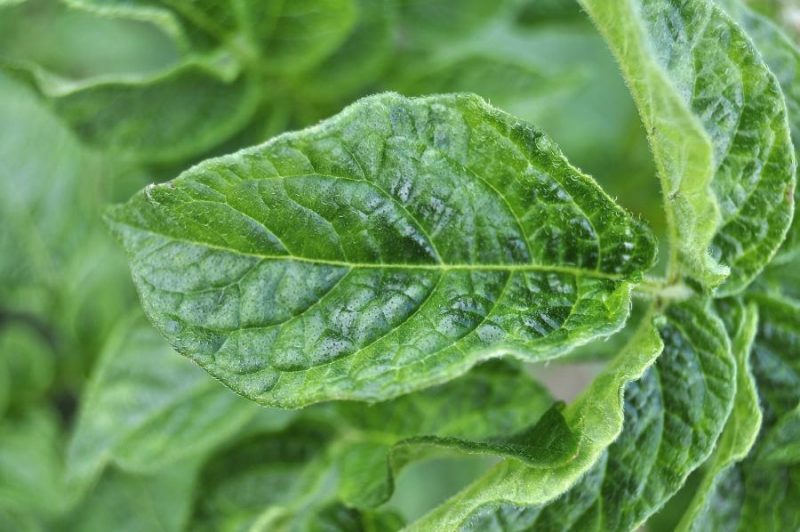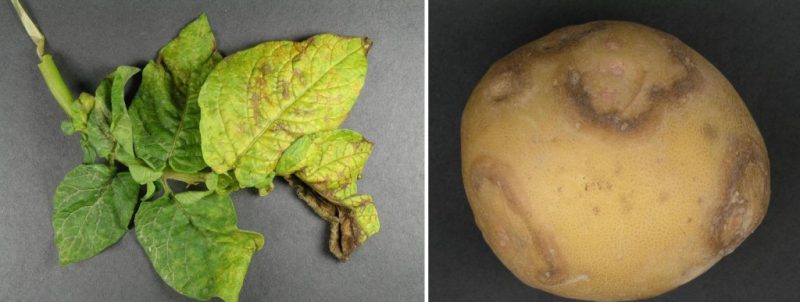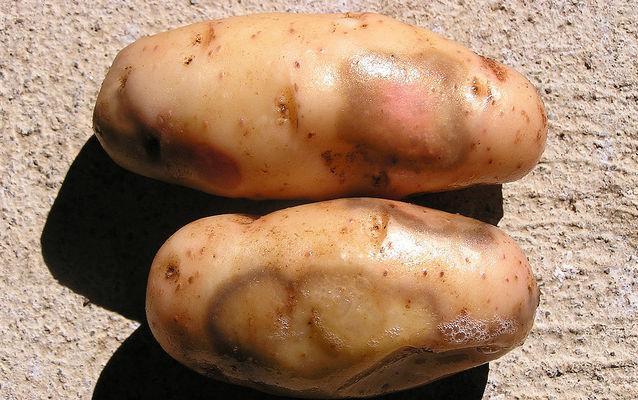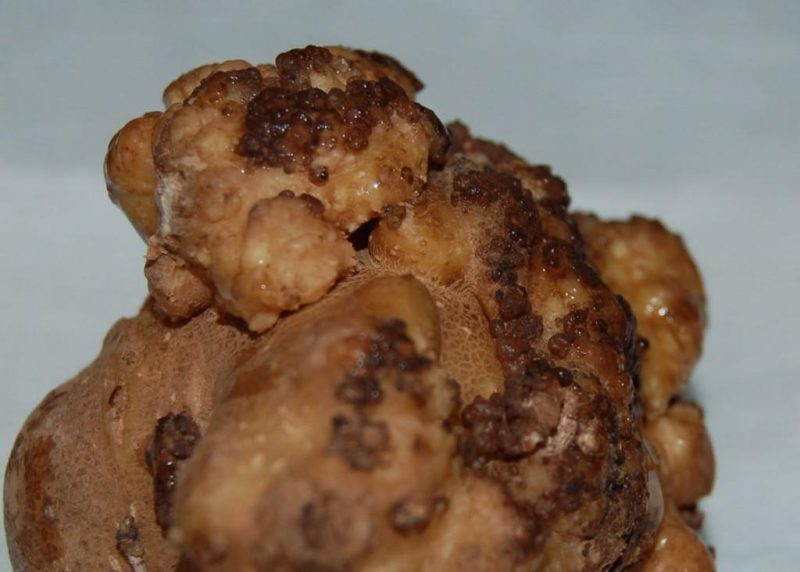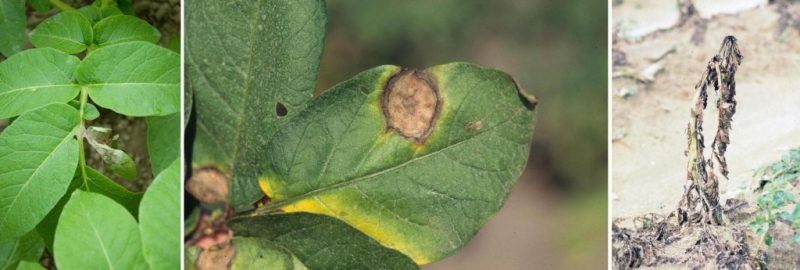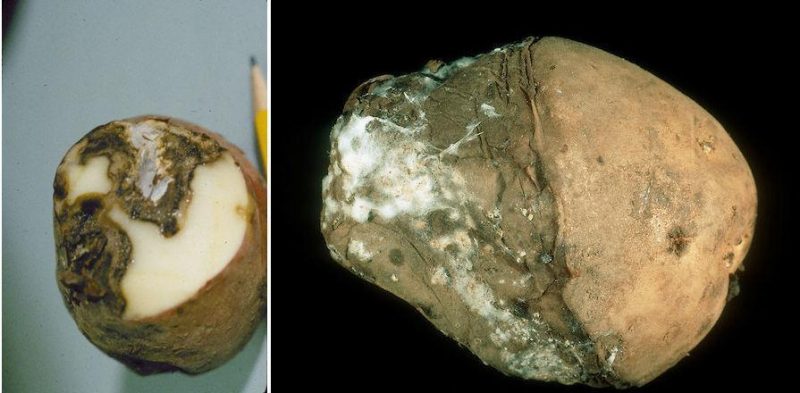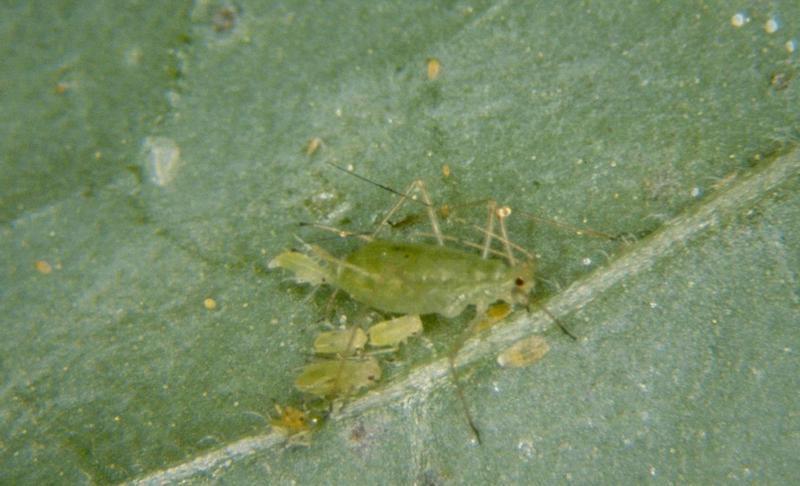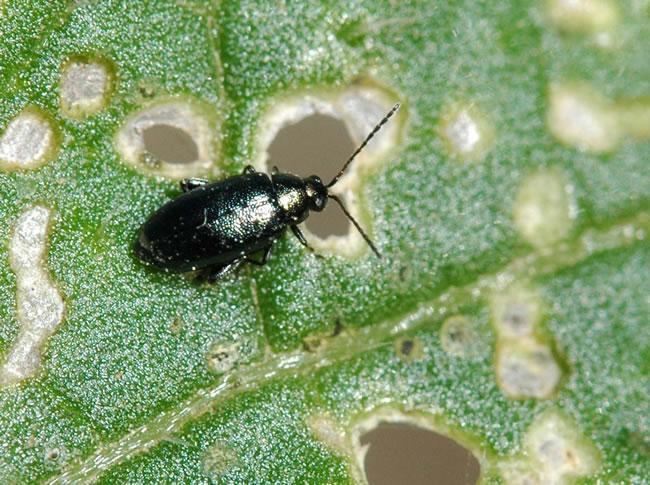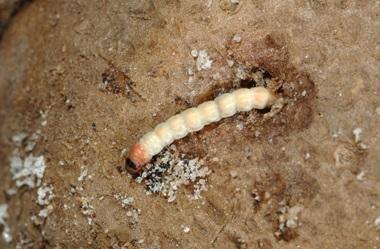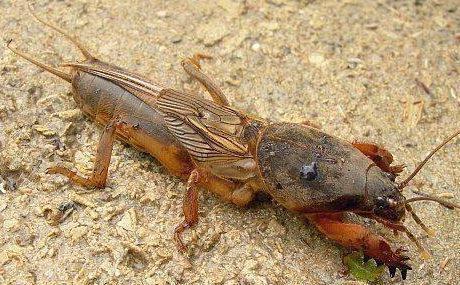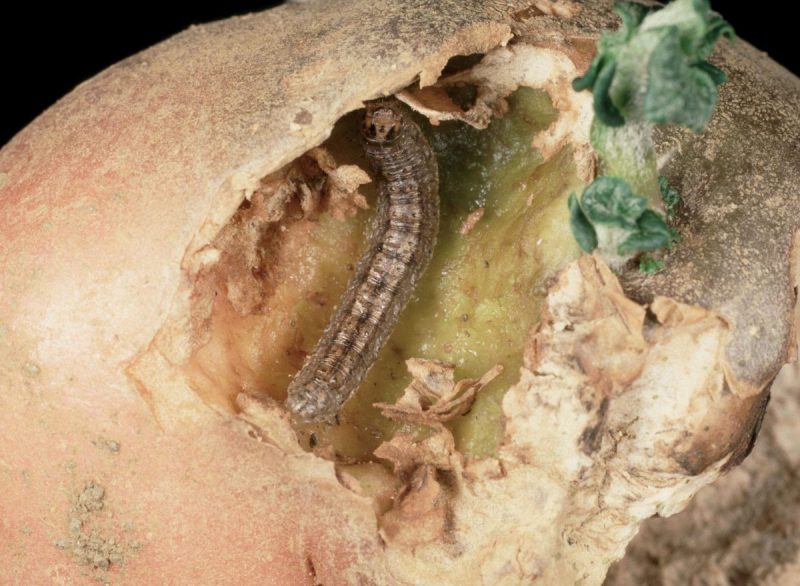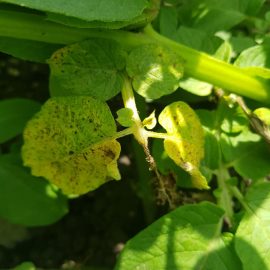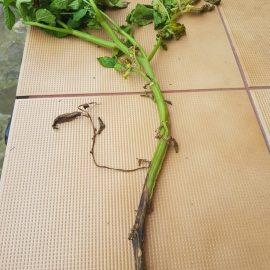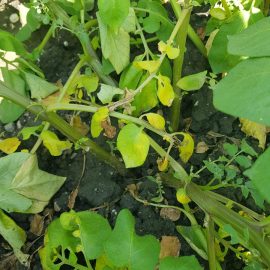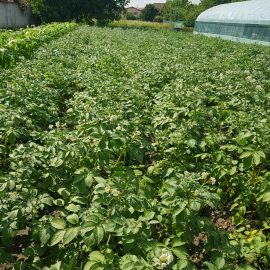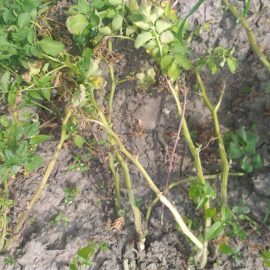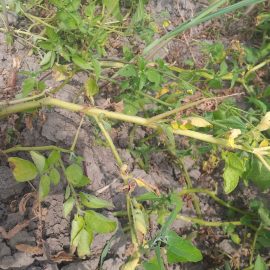Potato, treatments against pests and diseases
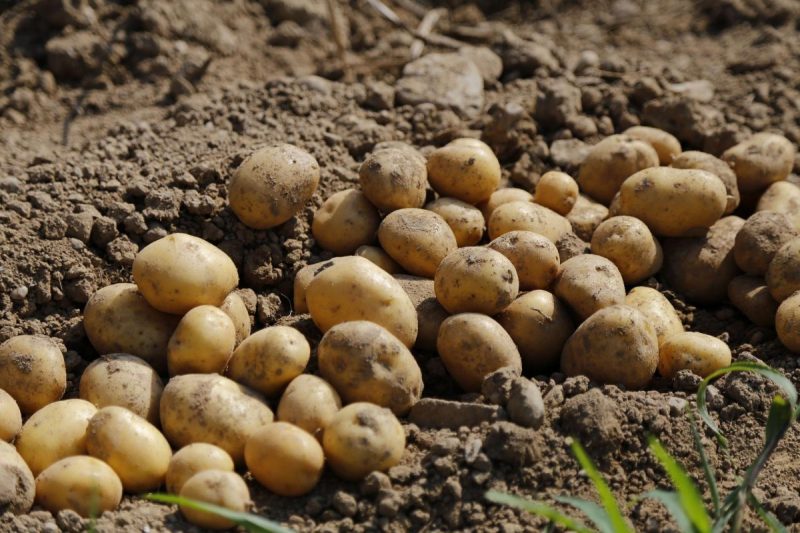
The potato (Solanum tuberosum) is a herbaceous plant in the Solanaceae family, with white or purple flowers and underground stems, forming round, oval, or elongated tubers. The plant is cultivated for starch-rich tubers, which is why they are used in food, but also as fodder. Potatoes are native to South America, in the Andes Mountains region. After rice, wheat, and corn, it is the fourth most consumed food. Also, the potato crop can grow on light soils, with a sandy-loamy texture, leaving the soil free of weeds. Potatoes can be affected by pests and diseases, against which it’s important to apply the right treatments.
The main diseases of potatoes
Viruses
Potato virus X
The attack manifests itself on the leaves as yellowish-green patches, alternating with symptom-free patches. In a more severe attack, the leaves become deformed and curled, followed by brownish-black necrotic spots and stripes. The same spots and necrotic stripes may appear on the petioles or stems. The virus is transmitted from one year to another through infected tubers, and during the growing season, by contact between healthy and diseased plants.
Prevention and control measures:
- growing resistant potato varieties and using healthy planting material;
- removing affected plants from the crop;
- avoiding plant injury.
Potato virus Y
The disease manifests itself on leaves and stems. Stripes, streaks, and necrotic spots appear on the attacked organs. The leaves wither, and dry, starting at the base, and then fall off the plant. After the attack, tuber production may decrease significantly. Plants grown from infected tubers are much smaller. The virus is transmitted via aphids and infected tubers.
Prevention and control measures:
- growing resistant potato varieties and using healthy planting material;
- removing affected plants from the crop;
- avoiding plant injury;
- carrying out specific insecticide treatments to keep the aphid population under control.
BACTERIOSIS
Potato blackleg disease (Pectobacterium atrosepticum)
Plants resulting from infected tubers remain small, with weak but erect stems. Leaves are yellowish-green, twisted and rigid. The stem base thins, blackens and the tissues rot. Diseased plants can be easily pulled up and do not produce tubers. In section through the affected tuber, there is a pinkish-purple discoloration of the vase ring. In a more advanced stage, cavities filled with bacterial mucilage form in the tuber, giving off an unpleasant odor, and the tuber flesh decomposes.
Prevention and control measures:
- using healthy saddling material;
- gathering and burning plant debris;
- avoiding sprinkler irrigation;
- storing tubers in appropriate conditions.
Mycosis
Potato wart disease (Synchytrium endobioticum)
The disease occurs on the potato’s underground organs (tubers, stolons), except for the roots, and less frequently at the stem base and on the basal leaves. Small, whitish, soft, fleshy growths appear on the attacked organs. Later, they grow, and turn brown and spongy, developing on the whole surface of the tuber, causing it to rot.
Prevention and control measures:
- growing resistant potato varieties and planting healthy tubers;
- removing affected plants from the crop.
Potato blight (Phytophthora infestans)
Potato blight attacks all organs of the plant. Yellowish spots appear on attacked leaves, initially small, with a diffuse outline and more numerous at the edge of the leaves. The spots gradually enlarge, become brown, then blackish-brown then surrounded by a yellowish stripe with irregular and diffuse margins. On the lower face, next to the spots, appears a fine, whitish fuzz. On the affected potatoes tubers, the disease manifests itself as brown, greyish-brown, or bluish spots.
Prevention and control measures:
- using healthy planting material;
- avoiding sprinkler irrigation;
- gathering and destroying plant debris in the fall;
- potato treatments with specific fungicides.
Recommended products
-
You can find products on a different store
Change Store -
You can find products on a different store
Change Store -
You can find products on a different store
Change Store -
You can find products on a different store
Change Store -
You can find products on a different store
Change Store -
You can find products on a different store
Change Store -
You can find products on a different store
Change Store -
You can find products on a different store
Change Store -
You can find products on a different store
Change Store -
You can find products on a different store
Change Store -
You can find products on a different store
Change Store -
You can find products on a different store
Change Store -
You can find products on a different store
Change Store -
You can find products on a different store
Change Store -
You can find products on a different store
Change Store -
You can find products on a different store
Change Store -
You can find products on a different store
Change Store -
You can find products on a different store
Change Store -
You can find products on a different store
Change Store -
You can find products on a different store
Change Store -
You can find products on a different store
Change Store -
You can find products on a different store
Change Store -
You can find products on a different store
Change Store -
You can find products on a different store
Change Store
Fusarium dry rot (Fusarium solani)
The attack is manifested on the tubers, where brown spots appear, near which the tissue becomes soft. The content of the tubers rots and turns brown, then dries and hardens. Gradually, the attacked tuber shrivels up and decreases its volume, the content turning into a strong, crumbly, white-yellow mass.
Prevention and control measures:
- using healthy planting material;
- avoiding sprinkler irrigation;
- gathering and destroying plant debris in the fall;
- storing tubers in appropriate conditions.
Potato early blight (Alternaria solani)
The disease occurs on leaves and stems causing dark, yellow-edged lesions that may form concentric areas. Affected leaves wilt, become deformed, and dry out, but will remain attached to the plant. The fungus can easily move from the leaves to the tubers, where it manifests itself as blackish-brown spots, near which the tissue rots.
Prevention and control measures:
- using healthy planting material;
- reducing plant stress through proper fertilization and irrigation;
- performing treatments with specific fungicides.
Recommended products
-
You can find products on a different store
Change Store -
You can find products on a different store
Change Store -
You can find products on a different store
Change Store -
You can find products on a different store
Change Store -
You can find products on a different store
Change Store -
You can find products on a different store
Change Store -
You can find products on a different store
Change Store -
You can find products on a different store
Change Store -
You can find products on a different store
Change Store -
You can find products on a different store
Change Store -
You can find products on a different store
Change Store -
You can find products on a different store
Change Store -
You can find products on a different store
Change Store -
You can find products on a different store
Change Store -
You can find products on a different store
Change Store -
You can find products on a different store
Change Store -
You can find products on a different store
Change Store -
You can find products on a different store
Change Store -
You can find products on a different store
Change Store -
You can find products on a different store
Change Store -
You can find products on a different store
Change Store -
You can find products on a different store
Change Store -
You can find products on a different store
Change Store -
You can find products on a different store
Change Store
The main potato pests
Cotton root-knot nematode (Meloidogyne incognita)
It is a polyphagous species, attacking over 1500 species of plants. The attack manifests itself with galls on the roots, which have different shapes and sizes. In case of a strong attack, the plants wilt.
Prevention and control measures:
- correct crop rotation;
- soil disinfection with specific products;
Potato rot nematode (Ditylenchus destructor)
It is a polyphagous species, but it mainly attacks potatoes. It has several generations per year and overwinters in all stages in potato stalks or tubers. On the aerial side, the attack is harder to notice. Discolored areas appear on the tubers, near which the epidermis dries and cracks. Following the attack, the tissues become brown and hard, with a parchment-like consistency.
Prevention and control measures:
- using healthy planting material;
- sorting and disposal of infested tubers;
- correct crop rotation;
- soil disinfection with specific products for potato treatments.
Wireworms (Agriotes spp.)
The larval stage of these pests is the one that causes damage and can last from 1 to 5 years. Attacked plants show wilting symptoms. Chemical control during the growing season is more difficult and it is recommended to apply control products before the crop is established.
Prevention and control measures:
- correct crop rotation;
- applying specific insecticides when planting/sowing.
Recommended products
-
You can find products on a different store
Change Store -
You can find products on a different store
Change Store -
You can find products on a different store
Change Store -
You can find products on a different store
Change Store -
You can find products on a different store
Change Store -
You can find products on a different store
Change Store -
You can find products on a different store
Change Store -
You can find products on a different store
Change Store -
You can find products on a different store
Change Store -
You can find products on a different store
Change Store -
You can find products on a different store
Change Store -
You can find products on a different store
Change Store -
You can find products on a different store
Change Store -
You can find products on a different store
Change Store -
You can find products on a different store
Change Store -
You can find products on a different store
Change Store -
You can find products on a different store
Change Store -
You can find products on a different store
Change Store -
You can find products on a different store
Change Store -
You can find products on a different store
Change Store -
You can find products on a different store
Change Store -
You can find products on a different store
Change Store -
You can find products on a different store
Change Store -
You can find products on a different store
Change Store
Cockchafer (Melolontha melolontha)
It is a polyphagous species and has a generation every 3-4 years. Adults attack leaves, sometimes also flowers and fruits in formation, in woody and herbaceous species. The larvae develop in the soil and attack the underground organs of plants (roots, tubers, etc.) In the case of potato tubers, the larvae produce galleries, encouraging pathogenic micro-organisms to enter.
Prevention and control measures:
- deep plowing and repeated tillage;
- applying specific insecticides when planting/sowing.
Recommended products
-
You can find products on a different store
Change Store -
You can find products on a different store
Change Store -
You can find products on a different store
Change Store -
You can find products on a different store
Change Store -
You can find products on a different store
Change Store -
You can find products on a different store
Change Store -
You can find products on a different store
Change Store -
You can find products on a different store
Change Store -
You can find products on a different store
Change Store -
You can find products on a different store
Change Store -
You can find products on a different store
Change Store -
You can find products on a different store
Change Store -
You can find products on a different store
Change Store -
You can find products on a different store
Change Store -
You can find products on a different store
Change Store -
You can find products on a different store
Change Store -
You can find products on a different store
Change Store -
You can find products on a different store
Change Store -
You can find products on a different store
Change Store -
You can find products on a different store
Change Store -
You can find products on a different store
Change Store -
You can find products on a different store
Change Store -
You can find products on a different store
Change Store -
You can find products on a different store
Change Store
Colorado potato beetle (Leptinotarsa decemlineata)
The Colorado potato beetle mainly attacks plants of the Solanaceae family, with significant damage to potatoes, tomatoes, and eggplants. The adults gnaw the leaves, producing irregular perforations on the leaf surface and eventually even skeletonizing them. The young larvae pierce the leaves. As they get older, they gnaw the leaves entirely, sometimes even the leaflets.
Prevention and control measures:
- deep autumn plowing;
- on small surfaces, larvae and adults can be collected manually;
- treatments with specific insecticides.
Recommended products
-
You can find products on a different store
Change Store -
You can find products on a different store
Change Store -
You can find products on a different store
Change Store -
You can find products on a different store
Change Store -
You can find products on a different store
Change Store -
You can find products on a different store
Change Store -
You can find products on a different store
Change Store -
You can find products on a different store
Change Store -
You can find products on a different store
Change Store -
You can find products on a different store
Change Store -
You can find products on a different store
Change Store -
You can find products on a different store
Change Store -
You can find products on a different store
Change Store -
You can find products on a different store
Change Store -
You can find products on a different store
Change Store -
You can find products on a different store
Change Store -
You can find products on a different store
Change Store -
You can find products on a different store
Change Store -
You can find products on a different store
Change Store -
You can find products on a different store
Change Store -
You can find products on a different store
Change Store -
You can find products on a different store
Change Store -
You can find products on a different store
Change Store -
You can find products on a different store
Change Store
Potato aphid (Macrosiphon euphorbiae)
It is a polyphagous pest, widespread in vegetable ponds. This pest develops 8-12 generations per year and overwinters as a resistant egg or as an active adult on infested crops. Adults and larvae cause damage by stinging apical leaves, leading to leaf cupping. Affected leaves and flowers turn yellow and dry out. Affected plants have poor growth and low yields. The aphids secrete a sticky liquid which they leave on the leaves, allowing saprophytic fungi of the genus Capnodium to settle in. The potato aphid is also an important vector for transmitting viruses.
Prevention and control measures:
- potatoes treatments with specific insecticides.
Recommended products
-
You can find products on a different store
Change Store -
You can find products on a different store
Change Store -
You can find products on a different store
Change Store -
You can find products on a different store
Change Store -
You can find products on a different store
Change Store -
You can find products on a different store
Change Store -
You can find products on a different store
Change Store -
You can find products on a different store
Change Store -
You can find products on a different store
Change Store -
You can find products on a different store
Change Store -
You can find products on a different store
Change Store -
You can find products on a different store
Change Store -
You can find products on a different store
Change Store -
You can find products on a different store
Change Store -
You can find products on a different store
Change Store -
You can find products on a different store
Change Store -
You can find products on a different store
Change Store -
You can find products on a different store
Change Store -
You can find products on a different store
Change Store -
You can find products on a different store
Change Store -
You can find products on a different store
Change Store -
You can find products on a different store
Change Store -
You can find products on a different store
Change Store -
You can find products on a different store
Change Store
Aphids
Aphids are small, green, or yellow insects found on the underside of leaves or stems. Depending on the species and the host plant, the pests may also have other colors. After the attack, the leaves turn yellow and deform and the buds remain small and undeveloped. The sweet secretions of these pests also called “honeydew”, favor the development of sooty mold on the leaves’ surface. Aphids are the main vectors in virus transmission.
Prevention and control measures:
- applying treatments with specific insecticides.
Recommended products
-
You can find products on a different store
Change Store -
You can find products on a different store
Change Store -
You can find products on a different store
Change Store -
You can find products on a different store
Change Store -
You can find products on a different store
Change Store -
You can find products on a different store
Change Store -
You can find products on a different store
Change Store -
You can find products on a different store
Change Store -
You can find products on a different store
Change Store -
You can find products on a different store
Change Store -
You can find products on a different store
Change Store -
You can find products on a different store
Change Store -
You can find products on a different store
Change Store -
You can find products on a different store
Change Store -
You can find products on a different store
Change Store -
You can find products on a different store
Change Store -
You can find products on a different store
Change Store -
You can find products on a different store
Change Store -
You can find products on a different store
Change Store -
You can find products on a different store
Change Store -
You can find products on a different store
Change Store -
You can find products on a different store
Change Store -
You can find products on a different store
Change Store -
You can find products on a different store
Change Store
Potato flea beetle (Epitrix cucumeris)
It overwinters as an adult, and in favorable weather conditions, it can have 3 generations per year. The adults appear in early spring and pinch potato leaves, while the larvae develop in the soil and bore galleries in the potato tubers.
Prevention and control measures:
- applying treatments with specific insecticides;
Recommended products
-
You can find products on a different store
Change Store -
You can find products on a different store
Change Store -
You can find products on a different store
Change Store -
You can find products on a different store
Change Store -
You can find products on a different store
Change Store -
You can find products on a different store
Change Store -
You can find products on a different store
Change Store -
You can find products on a different store
Change Store -
You can find products on a different store
Change Store -
You can find products on a different store
Change Store -
You can find products on a different store
Change Store -
You can find products on a different store
Change Store -
You can find products on a different store
Change Store -
You can find products on a different store
Change Store -
You can find products on a different store
Change Store -
You can find products on a different store
Change Store -
You can find products on a different store
Change Store -
You can find products on a different store
Change Store -
You can find products on a different store
Change Store -
You can find products on a different store
Change Store -
You can find products on a different store
Change Store -
You can find products on a different store
Change Store -
You can find products on a different store
Change Store -
You can find products on a different store
Change Store
Potato tuber moth (Phthorimaea operculella)
The adults emerge in spring and lay their eggs on the aerial parts of the plants. Larvae produce galleries in potatoes leaves and stems. On tubers, the larvae produce galleries, which are lined with silk threads in the form of a fuzz. Newly attacked areas are pink.
Control measures:
- chemical treatments with specific insecticides.
Recommended products
-
You can find products on a different store
Change Store -
You can find products on a different store
Change Store -
You can find products on a different store
Change Store -
You can find products on a different store
Change Store -
You can find products on a different store
Change Store -
You can find products on a different store
Change Store -
You can find products on a different store
Change Store -
You can find products on a different store
Change Store -
You can find products on a different store
Change Store -
You can find products on a different store
Change Store -
You can find products on a different store
Change Store -
You can find products on a different store
Change Store -
You can find products on a different store
Change Store -
You can find products on a different store
Change Store -
You can find products on a different store
Change Store -
You can find products on a different store
Change Store -
You can find products on a different store
Change Store -
You can find products on a different store
Change Store -
You can find products on a different store
Change Store -
You can find products on a different store
Change Store -
You can find products on a different store
Change Store -
You can find products on a different store
Change Store -
You can find products on a different store
Change Store -
You can find products on a different store
Change Store
European mole cricket (Gryllotalpa gryllotalpa)
It is a polyphagous species, found in many regions. It attacks the underground organs of plants, cuts roots, and produces galleries and galls in tubers.
Control measures:
- soil treatments with specific products.
Turnip moth (Agrotis segetum)
It has 2 generations a year and overwinters as a larva of different ages in the soil. Adults are not dangerous, but the larvae feed on all parts of the plant, preferring the area between the roots and the stem and the tubers, where they gnaw holes.
Control measures:
- chemical treatments with specific insecticides.
Recommended products
-
You can find products on a different store
Change Store -
You can find products on a different store
Change Store -
You can find products on a different store
Change Store -
You can find products on a different store
Change Store -
You can find products on a different store
Change Store -
You can find products on a different store
Change Store -
You can find products on a different store
Change Store -
You can find products on a different store
Change Store -
You can find products on a different store
Change Store -
You can find products on a different store
Change Store -
You can find products on a different store
Change Store -
You can find products on a different store
Change Store -
You can find products on a different store
Change Store -
You can find products on a different store
Change Store -
You can find products on a different store
Change Store -
You can find products on a different store
Change Store -
You can find products on a different store
Change Store -
You can find products on a different store
Change Store -
You can find products on a different store
Change Store -
You can find products on a different store
Change Store -
You can find products on a different store
Change Store -
You can find products on a different store
Change Store -
You can find products on a different store
Change Store -
You can find products on a different store
Change Store














































































































































































































































































































































































































































